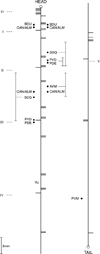A specific antibody to neuropeptide AF1 (KNEFIRFamide) recognizes a small subset of neurons in Ascaris suum: differences from Caenorhabditis elegans
- PMID: 21452223
- PMCID: PMC4769036
- DOI: 10.1002/cne.22584
A specific antibody to neuropeptide AF1 (KNEFIRFamide) recognizes a small subset of neurons in Ascaris suum: differences from Caenorhabditis elegans
Abstract
A monoclonal antibody, AF1-003, highly specific to the Ascaris suum neuropeptide AF1 (KNEFIRFamide), was generated. This antibody binds strongly to AF1 and extremely weakly to other peptides with C-terminal FIRFamide: AF5 (SGKPTFIRFamide), AF6 (FIRFamide), and AF7 (AGPRFIRFamide). It does not recognize 35 other AF (A. suum FMRFamide-like) peptides at the highest concentration tested, nor does it recognize FMRFamide. When crude peptide extracts of A. suum are fractionated by two-step HPLC, the only fractions recognized by AF1-003 are those comigrating with synthetic AF1. By immunocytochemistry, antibody AF1-003 recognizes a small subset of the 298 neurons of A. suum: these include the paired URX and RIP neurons, two pairs of lateral ganglion neurons in the head, and the unpaired PQR and PDA or -B tail neurons that send processes to the head along the dorsal and ventral nerve cords, respectively. AF1 immunoreactivity is also seen in three pairs of pharyngeal neurons. Mass spectroscopy (MS) shows the presence of AF1 in the head, pharynx, and dorsal and ventral nerve cords. In A. suum, the neurons that contain AF1 show little overlap with neurons that express green fluorescent protein constructs targeting the flp-8 gene, which encodes AF1 in Caenorhabditis elegans (Kim and Li [2004] J. Comp. Neurol. 475:540-550); the URX neurons express AF1 in both species, but, in C. elegans, flp-8 expression was not detected in RIP, PQR, and PDA or -B or in the pharynx. Other, less specific monoclonal antibodies recognize AF1, as well as other peptides to differing degrees; these antibodies are useful reagents for determination of neuronal morphology.
Copyright © 2010 Wiley-Liss, Inc.
Figures








Similar articles
-
Changes in locomotory behavior and cAMP produced in Ascaris suum by neuropeptides from Ascaris suum or Caenorhabditis elegans.Mol Biochem Parasitol. 2000 Nov;111(1):185-97. doi: 10.1016/s0166-6851(00)00317-0. Mol Biochem Parasitol. 2000. PMID: 11087928
-
The ovijector of Ascaris suum: multiple response types revealed by Caenorhabditis elegans FMRFamide-related peptides.Int J Parasitol. 2003 Jul 30;33(8):859-76. doi: 10.1016/s0020-7519(03)00109-7. Int J Parasitol. 2003. PMID: 12865086
-
Role of a FMRFamide-like family of neuropeptides in the pharyngeal nervous system of Caenorhabditis elegans.J Neurobiol. 2005 Dec;65(3):304-19. doi: 10.1002/neu.20201. J Neurobiol. 2005. PMID: 16187307
-
FMRFamide-related peptides (FaRPs) in nematodes: occurrence and neuromuscular physiology.Parasitology. 1996;113 Suppl:S119-35. doi: 10.1017/s0031182000077933. Parasitology. 1996. PMID: 9051931 Review.
-
The ever-expanding neuropeptide gene families in the nematode Caenorhabditis elegans.Parasitology. 2005;131 Suppl:S109-27. doi: 10.1017/S0031182005009376. Parasitology. 2005. PMID: 16569285 Review.
Cited by
-
Family of FLP Peptides in Caenorhabditis elegans and Related Nematodes.Front Endocrinol (Lausanne). 2014 Oct 14;5:150. doi: 10.3389/fendo.2014.00150. eCollection 2014. Front Endocrinol (Lausanne). 2014. PMID: 25352828 Free PMC article. Review.
-
Mass spectrometric evaluation of neuropeptidomic profiles upon heat stabilization treatment of neuroendocrine tissues in crustaceans.J Proteome Res. 2013 Feb 1;12(2):743-52. doi: 10.1021/pr300805f. Epub 2013 Jan 2. J Proteome Res. 2013. PMID: 23227893 Free PMC article.
-
Different neuropeptides are expressed in different functional subsets of cholinergic excitatory motorneurons in the nematode Ascaris suum.ACS Chem Neurosci. 2015 Jun 17;6(6):855-70. doi: 10.1021/cn5003623. Epub 2015 Apr 9. ACS Chem Neurosci. 2015. PMID: 25812635 Free PMC article.
-
Three independent techniques localize expression of transcript afp-11 and its bioactive peptide products to the paired AVK neurons in Ascaris suum: in situ hybridization, immunocytochemistry, and single cell mass spectrometry.ACS Chem Neurosci. 2013 Mar 20;4(3):418-34. doi: 10.1021/cn3001334. Epub 2012 Dec 27. ACS Chem Neurosci. 2013. PMID: 23509978 Free PMC article.
-
Changes in cyclic nucleotides, locomotory behavior, and body length produced by novel endogenous neuropeptides in the parasitic nematode Ascaris suum.Mol Biochem Parasitol. 2011 Nov;180(1):27-34. doi: 10.1016/j.molbiopara.2011.08.001. Epub 2011 Aug 10. Mol Biochem Parasitol. 2011. PMID: 21854812 Free PMC article.
References
-
- Berman ES, Fortson SL, Checchi KD, Wu L, Felton JS, Wu KJ, Kulp KS. Preparation of single cells for imaging/profiling mass spectrometry. J Am Soc Mass Spectrom. 2008;19:1230–1236. - PubMed
-
- Brownlee DJA, Fairweather I. Exploring the neurotransmitter labyrinth in nematodes. Trends Neurosci. 1999;22:16–24. - PubMed
-
- Brownlee DJA, Walker RJ. Actions of nematode FMRFa-miderelated peptides on the pharyngeal muscle of the parasitic nematode, Ascaris suum . Ann NY Acad Sci. 1999;897:228–238. - PubMed
-
- Brownlee DJA, Fairweather I, Johnston CF, Smart D, Shaw C, Halton DW. Immunocytochemical demonstration of neuropeptides in the central nervous system of the round-worm, Ascaris suum (Nematoda, Ascaroidea) Parasitology. 1993;106:305–316. - PubMed
-
- Cowden C, Stretton AOW. AF2, an Ascaris neuropeptide: isolation, sequence, and bioactivity. Peptides. 1993;14:423–430. - PubMed
Publication types
MeSH terms
Substances
Grants and funding
LinkOut - more resources
Full Text Sources
Miscellaneous

